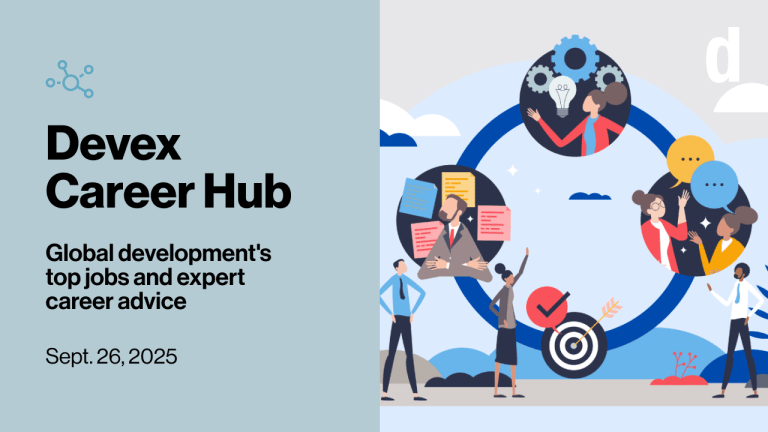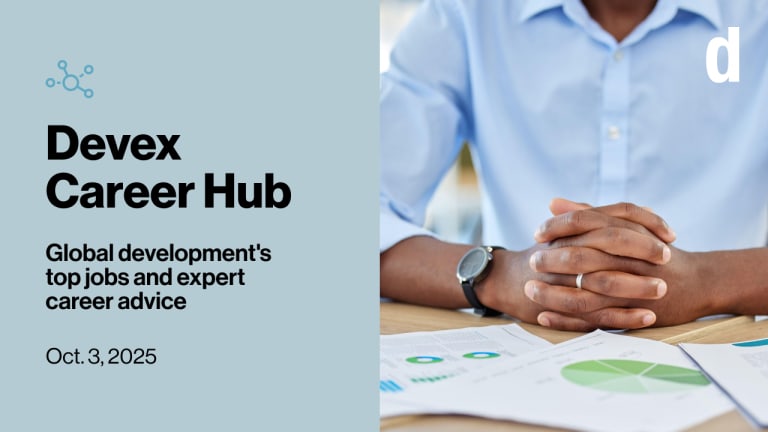How to make disability a priority in your development project
CBM Australia has a decade of experience in providing disability-inclusive advice and support to Australia's aid program. Devex spoke with CBM’s Raine Dixon, for her tips on incorporating disability in the design of all development and humanitarian programs.
CANBERRA — The announcement from CBM Australia of a new agreement with the Department of Foreign Affairs and Trade to support disability inclusion across the Australian aid program until 2020, following a decade of support to DFAT, makes them an important resource for NGOs and donors to learn about how they can improve disability support within their own programs. “There are a range of different types of disability and you need to think broadly.” --— Raine Dixon, director of the inclusive development department, CBM Australia Devex spoke with CBM’s director of the inclusive development department, Raine Dixon, for her tips and advice on ensuring disability be an important consideration in the design of all development and humanitarian programs. Here they are. 1. Disability inclusion needs to be more than tokenistic A common mistake, Dixon explained, is that in researching, designing, and developing development programs, disability is not always a consideration. Her key tip for development professionals is: Think disability. “Disability is cross cutting it applies to your program as well,” Dixon explained would be her key advice. “Remember, it's not just about physical disability. There are a range of different types of disability and you need to think broadly.” And after considering disability, it needs to be built into systems and designs in a very comprehensive way. “Don't make disability tokenistic,” Dixon warned. “You need to build it, but you need to build it into your monitoring and evaluation and build it into your consultations. You need to build in accessibility and all those things, and there is no reason this cannot be done very effectively to make your development program easier.” Common standards, approaches, and methods will simplify the integration of disability inclusion and better target disability outcomes within all areas of aid and development support. 2. Get advice from the experts The journey to making aid and development programs disability-inclusive requires support, and Dixon says there is a wealth of support available to assist — from people with a disability. “Get some advice, because there are lots of lessons around how it can be done,” Dixon advised. “And most importantly, talk to people with disabilities or their representative organisations about how to do it and then be prepared to build into your programs.” Consultation is a critical component in making sure disability is effectively targeted in all programs, but does not always occur. 3. Share your knowledge The lessons of what is effective in supporting people with disability is important — and Dixon says all knowledge organization gain through their programs should be shared widely. “We're trying to beef up that evidence,” Dixon said. “We are looking for opportunities to share lessons and encouraging others to do the same.” The Nossal Institute of Global Health, CBM’s partner in providing disability-inclusive services to DFAT, provides an example of the information and resources that can be shared. And each bit of information available can help other donors, NGOs, and organizations supporting disability inclusion on their path to success. 4. For disability groups, utilize training to communicate to donors While Dixon has a range of important advice to donors, disability groups can also help to bridge the gaps — and there are training programs available to support then “One of the things though I would say, and one of the things that we've supported to some extent within DFAT, is an International Disability Alliance program called BRIDGE,” Dixon said. “This is about bringing together the perspective or understandings of disability and understandings of development into a single set of training courses. And for disability groups, it gets them across how to talk to donors on development issues. It is important for them to have this capability to communicate, on donor terms, what they need support with.” 5. Expert staff are hard to come by and have to be developed An important final consideration is that, for organizations planning to employ expertise from within, it is not always easy to come by. “One of the real challenges that we have here anyway is just finding people with the right expertise,” Dixon explained. “It's quite a specific skill set, so we have to bring people in and then scale them up in here. They either come in with disability or development skills, and need to build up a knowledge of both. It's a huge challenge for us to keep pulling people in, training them and then have them go out.” One of the things Dixon finds is that they often develop new staff with a health or disability background and then have done a volunteer stint — and they have developed an interest in development. “That is quite a good place to start,” Dixon said. “Others have come from DFAT or from development agencies and been exposed to something that was disability-related, and just picked up an interest in disability. And then there’s word of mouth and networks because staff working in this area tend to really enjoy what they do.” But to support these new staff, there needs to be strong leadership in the desire to train up the skills require — which can lead to wider dissemination of knowledge and skills.
CANBERRA — The announcement from CBM Australia of a new agreement with the Department of Foreign Affairs and Trade to support disability inclusion across the Australian aid program until 2020, following a decade of support to DFAT, makes them an important resource for NGOs and donors to learn about how they can improve disability support within their own programs.
Devex spoke with CBM’s director of the inclusive development department, Raine Dixon, for her tips and advice on ensuring disability be an important consideration in the design of all development and humanitarian programs. Here they are.
A common mistake, Dixon explained, is that in researching, designing, and developing development programs, disability is not always a consideration. Her key tip for development professionals is: Think disability.
This story is forDevex Promembers
Unlock this story now with a 15-day free trial of Devex Pro.
With a Devex Pro subscription you'll get access to deeper analysis and exclusive insights from our reporters and analysts.
Start my free trialRequest a group subscription Printing articles to share with others is a breach of our terms and conditions and copyright policy. Please use the sharing options on the left side of the article. Devex Pro members may share up to 10 articles per month using the Pro share tool ( ).
Lisa Cornish is a former Devex Senior Reporter based in Canberra, where she focuses on the Australian aid community. Lisa has worked with News Corp Australia as a data journalist and has been published throughout Australia in the Daily Telegraph in Melbourne, Herald Sun in Melbourne, Courier-Mail in Brisbane, and online through news.com.au. Lisa additionally consults with Australian government providing data analytics, reporting and visualization services.








